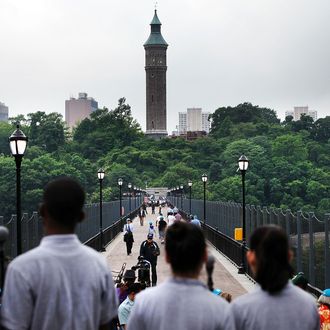
In theory, a bridge exists to link places that need connecting, but for six decades, the High Bridge connected nothing at all. It leapt between two steep, weedy escarpments on either side of the Harlem River, over highways and ramps and railways. Until Tuesday, it might have saved itself even that trouble. The bridge spent the last 45 years derelict and padlocked, an abandoned bit of 19th-century glory that was of no use to anyone — certainly not to the residents of the Bronx neighborhood called Highbridge. Now, after a $61 million renovation, the bridge has reopened to pedestrians and bikers, and though it may take a while for the Sims on either side to discover a new byway and start flowing across, eventually the psychological map of New York will make a small but important adjustment. Suddenly, people have a new direction in which to walk, and a new reason to do so.
Built in 1848 to carry fresh water across river water on its way to the Croton Reservoir at 42nd Street, the High Bridge bore pedestrians, too, who came to stroll back and forth between rural upper Manhattan and the even more rural Bronx. Down below, within spitting and tossing range of the bridge, swells raced their carriages along the Harlem Speedway. Edgar Allan Poe is said to have hiked to this spot over the Bronx’s rocky terrain from his cottage on the Kingsbridge Road, where his wife was slowly expiring of tuberculosis. A lithograph by B.J. Rosenmeyer shows the writer, a year before his own death, trudging through the snow over a wind-whipped viaduct, the cliffs behind him plunging to the river below. To retrace his whole itinerary on foot today would be a demoralizing experience: beneath the elevated No. 6 train and over the Cross Bronx Expressway, past a wilderness of ramps and forests of housing projects. Laced with truck routes, sundered from Manhattan by a wide ravine and traffic-choked bridges, the South Bronx is friendly only to the most committed pedestrians.
Today, though, the area’s residents can stroll — or pedal — to the western end of 170th Street, which once ended at a chain-link fence, and head down a small flight of stairs, onto the bridge’s handsome brickwork, out over the Harlem River, and across to the steep and densely foliated Highbridge Park. Bear left and the path spills onto Edgecombe Avenue, following the picturesque cliffs of Washington Heights, past the Morris-Jumel Mansion (and the Edgecombe Correctional Facility) to the gracious precincts of Sugar Hill, the heart of the Harlem Renaissance. It wasn’t impossible to come this way before, but it wasn’t pleasant, either. Now it is.
Preserving a tumbledown relic can sometimes look like a fussy exercise in antiquarian aesthetics. But fixing up an obsolete aqueduct and the old footbridge on top — a delayed legacy of the Bloomberg administration and Adrian Benepe’s tenure as parks commissioner — has made the city more mobile, and therefore more free. Manhattanites take for granted that they can walk out of their homes, turn left or right, and walk for as long as they wish. But anyone who’s ever lived in an area bounded by barbed wire, train tracks, and highways knows how much the experience of a neighborhood depends on the ability to leave it on foot.






























